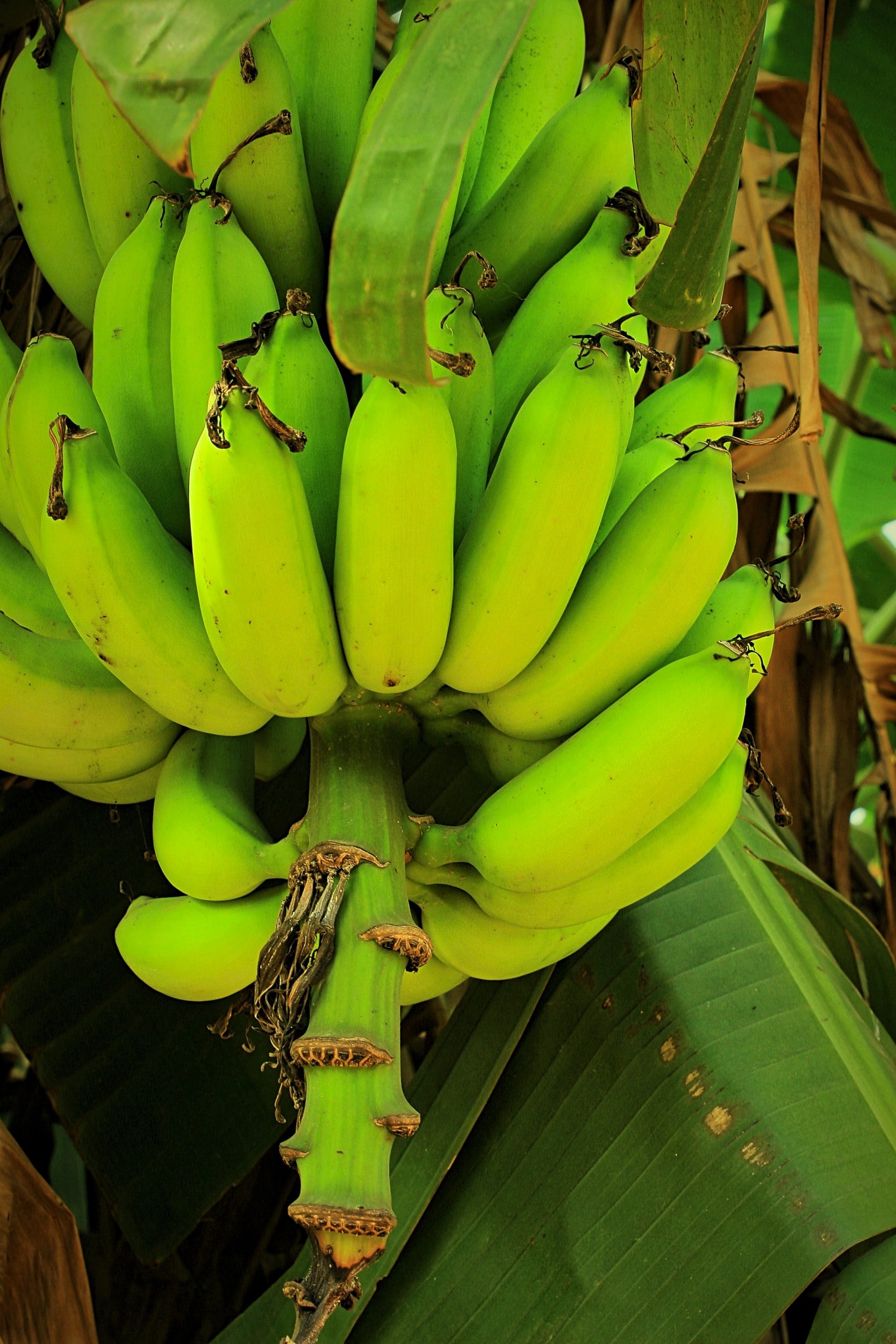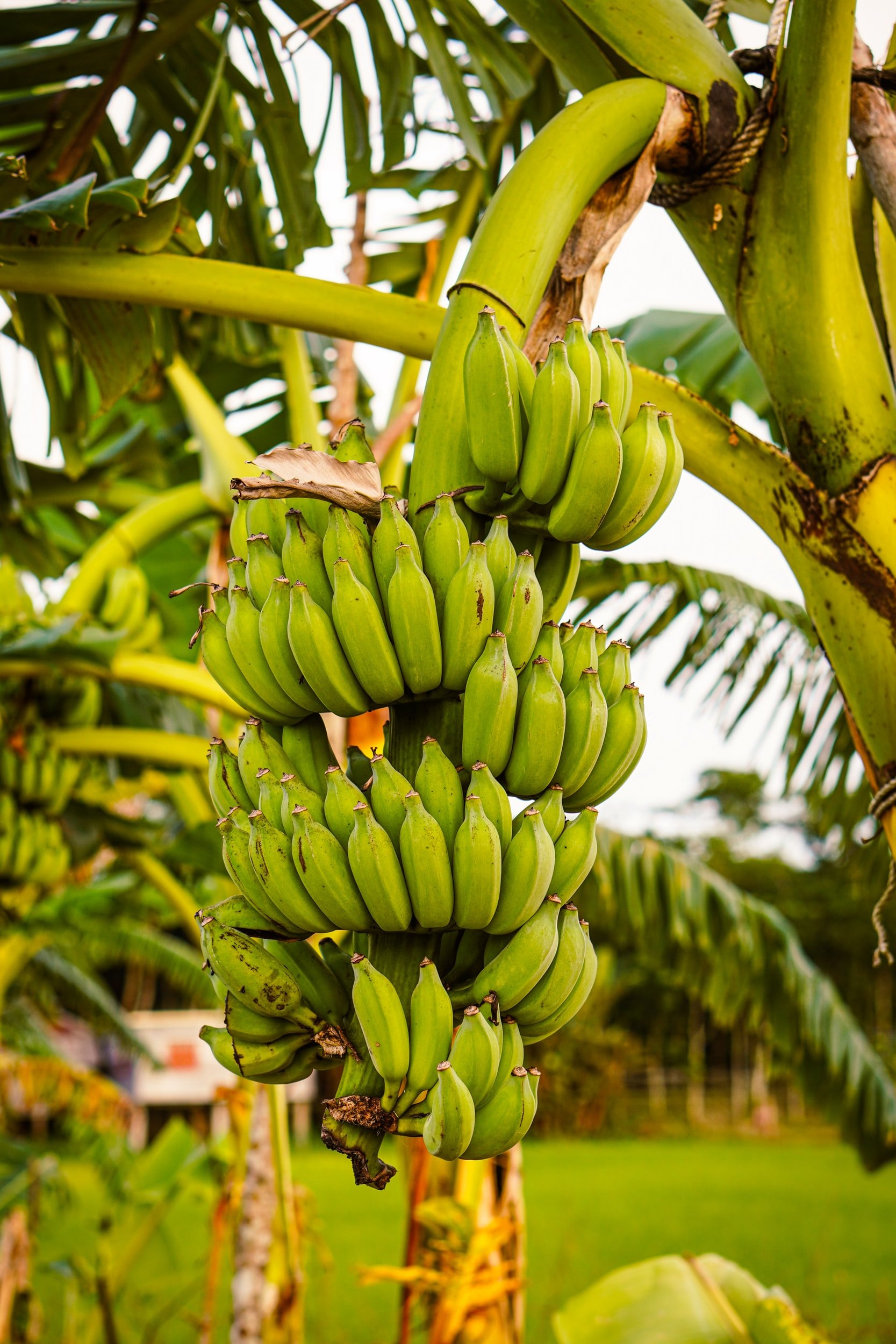How to Care and Harvest from a Banana Tree
A Banana’s scientific name translates to “Fruit of the Wise Men” (musa sapientum). Considering how useful they are to our health and garden, there’s no surprise how logical it is to cultivate them. It is believed that there are over 1,000 different species in the world. The best part about banana trees is the end result, bananas filled with potassium and vitamin C. In my experience, they have to be one of the easiest plants to grow in tropical climates. For new growers, knowing when your fruiting stalks are ready will help you stay ahead of any pests or issues.
Is it ready yet?
If you’ve never harvested from a banana tree before, you’ll probably ask, “How do I know when they are ready”? After you see the banana has produced a purple flower, it indicates the tree is starting to fruit. Over time you’ll see the flower form clusters or hands of bananas down a ridged stalk.
Banana Flower forming new bananas
These hands will continue to form and will take around 2-3 months from flower to mature fruit. Once the bananas start forming you’ll notice they will be dark green, feel solid to the touch and have sharp, pronounced edges along the body.
The tough texture and sharp edges indicate these bananas are still maturing.
The main indicator of your bananas maturing will be the shape of the fruit body. While they are still stiff and ridged, leave them to continue developing. While maturing, they will gradually swell and the fruit body will start to round out. You’ll notice the edges will smooth out as well, indicating that this rack is ready to be cut down. Another option is to wait until the top bananas start to turn yellow before you cut them down.
The rounded shape of the bananas indicate they are mature and ready to harvest
Protect your Racks
While waiting for them to ripen, leaving the bananas on the tree makes them susceptible to other animals with a sweet tooth as well. Personally, I usually don’t protect my banana racks because I haven’t experienced any major pest problems. However, there was a rack recently that I left too long on the tree which became the main entrée for a family of raccoons…on second thought, maybe I should take my own advice. If you do decide to protect them, it will give you peace of mind and less to worry about.
It’s best to protect bananas with some type of cover or material that will house the bunch as it ripens. One option is floating row covers, which are sheets of fabric made of woven plastic, polypropylene, natural fiber, plastic, or polyester material that provide cover without blocking elements like water, wind, and sunlight to pass through. Doing so will deter many different bugs, fruit flies, bats, and birds from pecking at your fruit.
Cutting down your Bananas
After your banana rack is mature and ready to harvest, it’s time to start chopping. Depending on the size of your tree and rack, you may need to take certain precautions while cutting them down. For example, If you have a tall banana tree that’s way out of arm’s reach, it would be easier to use a ladder to cut down the rack or just level the whole tree instead. Of course, if you have to level the tree then be careful to guide it down without damaging the fruit.
The best place to cut the rack off the tree will be just above the top cluster of fruit.
Cut the stalk just above the top hand of bananas to harvest
Afterwards you’ll need to store them in a cool area so they can continue ripening. Depending on how huge and heavy the rack is, it may be best to cut several of the hands off to make it easier to carry and store. My favorite way to store them is to hang the rack up underneath shelter so they can ripen from the top down.
Something to be aware of with banana trees is they only fruit once during their lifetime. After they produce, that’s it for that tree. Since the tree gathers and stores a multitude of nutrients I find it best to redistribute the resources back to the garden or other banana trees. To do this we’ll need to chop down the tree to about 30 inches above the soil so it doesn’t damage the corm. The corm is the plant structure underneath the soil that produces the roots and form new banana plants. After the tree is cut down I like to cut the stem into long pieces about 1 foot in length, then divide those pieces in half longways. With the pieces split, we can lay them down around other banana trees to feed them nutrients and aid their production. They can also be used as borders for your garden beds.
Growing Maximum Yield Producing Bananas
Banana trees are known as heavy-feeders, meaning they love to be watered and fertilized around the clock. As a rule of thumb, you can say that they can’t be fed enough. They love sunlight, water, fertilizer, compost and plant matter. The 2 most important factors when planting a tree is sunlight and water. Pick a location where your tree will have full-sun coverage (6+hours) and if possible, an area like a burm, slope or a dip where it will be easier for it to hold moisture.
Mulch
Mulch is such an integral garden support system that helps in doing a lot of the work for you.
It helps to insolate your garden from extreme temperatures, breaks down organic matter, holds moisture, prevents erosion, builds soil and guards against weeds.
Covering the base and surrounding area of your banana trees will provide a huge help in your plant’s overall health.
Fertilizing
Bananas require a lot of fertilizer to produce healthy fruit. You should look to fertilize your banana plant about once a month. During the winter months, banana trees go dormant and will halt production so I recommend refraining from fertilizing then. You can fertilize them naturally or get an organic granular fertilizer with an 8-10-8 NPK ratio. The most common deficiencies in bananas are Nitrogen and Potassium so you’ll want to give them a good supply of both.
For a natural supply of Potassium, I recommend taking banana peels and placing them in a bucket or jar of water for 1 week. As the peels sit in the water, the potassium will slowly extract from the peel. The peel will possibly liquidize in the process as well. After a week you can pour the liquid mixture at the base of the tree to target the roots. If you are using mulch under your bananas the roots will sap liquid from the soil with the potassium mix over time.
Coffee grounds are a great source of natural Nitrogen. If you are an avid coffee drinker and have a setup at home then be sure to save your grounds. You can also visit coffee shops and ask if they have any leftover grounds to give away. I’ve been lucky to get repeated 5lb bags of grounds from Starbucks. To apply them to your garden you can either apply them to the soil directly or let them steep in water overnight before adding the mix to the garden.
Banana Pups
As your tree grows, you will start to see little bananas start rising up from the base. These are banana pups being produced by the corm growing underneath. A great thing about this plant is that it will continue to multiply itself if it is healthy. Ideally, you can populate an entire garden space with countless banana trees all from one original. Although, these new pups will halt the growth of your main tree as they are using the same source of nutrients. I found it best to remove the pups as they pop up and relocate them to their own area.
The younger banana pups grow from the base of the original.
You have to be careful when removing them so as not to damage the corm below. It’s best to clear the space around the pup and check if it has any roots growing underneath. If it has good roots then use a tool to cut and separate it from the mother tree. You can then replant it and restart the cycle again.
Banana Triangle
If you plant bananas in a wide triangle you can even use the middle as a compost pile. Just bury your food scraps in the middle and cover it with mulch. The bananas will feed off the scraps and the soil underneath will be enriched over time, it’s a win-win situation.
Easy Plant with Many Uses
Bananas are rich in Calcium, Potassium, Vitamin C, folic acid and anti-oxidants. They are also a great source of carbs and are often used to aid in building mass and muscle after workouts. The peel can be used to treat animal bites on the skin. Furthermore, People have used them for face masks and shoe shine for leather shoes. In all, they have various uses which all prove beneficial, making them a largely useful, easy plant to grow.








